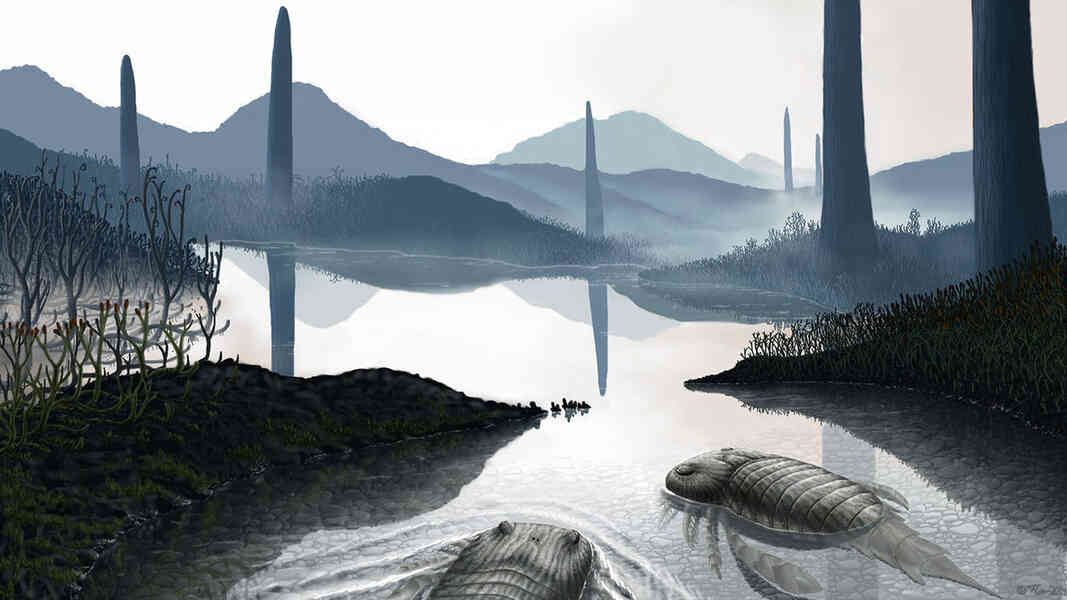Earth’s Forgotten Giants: The Enigma of Prototaxites
A fossil oddity rewrites Earth’s evolutionary playbook

Picture this: 420 million years ago, Earth’s land is a soggy, alien sprawl. Tiny mosses cling to the dirt, barely ankle-high. No trees, no dinosaurs—just a quiet, damp world. Then, bam! Giant towers loom up to 26 feet tall, dwarfing everything. These aren’t plants or fungi as we know them. They’re Prototaxites, and as of March 30, 2025, they’re shaking up science with a mind-blowing twist: they might be a totally unknown branch of life. Buckle up, science geeks—this is evolutionary history getting a cosmic remix!
The Fossil That Broke the Mold
First dug up in 1843 by a curious Canadian geologist, John William Dawson, Prototaxites looked like petrified tree trunks—some stretching 8.8 meters long and 1 meter wide. Found in places like Quebec, Saudi Arabia, and Scotland, these fossils screamed “big deal.” Back then, Dawson pegged them as rotting conifers, but he was off. Way off. Trees didn’t even exist yet! By 1859, he named them Prototaxites, meaning “first yew,” kicking off a 165-year debate that’s still raging.
Fast forward to March 17, 2025. A preprint study on bioRxiv—straight from the University of Edinburgh—drops a bombshell. Researchers, led by paleobiologist Corentin Loron, zoomed into Prototaxites taiti, a smaller species from Scotland’s Rhynie chert. This fossil bed, sealed by volcanic ash 407 million years ago, is a goldmine of pristine relics. Unlike its towering cousins, P. taiti tops out at a few inches, but its insides? Pure geek candy. Tubes twist and reconnect in ways no modern fungus, plant, or animal can match. Stats hit hard: these structures pack tubes as thin as 5 micrometers, weaving a network that defies everything we know.
Not a Fungus, Not a Plant—What Is It?
For decades, scientists volleyed theories. Giant algae? Nope, too complex. A lichen mash-up? Cool idea, but the anatomy flops. In 2007, Stanford’s Kevin Boyce used carbon isotopes to argue Prototaxites was a mega-fungus, slurping up dead stuff like a prehistoric vacuum. His team clocked isotope ratios swinging wild—way beyond plants’ tidy patterns. It made sense: fungi don’t photosynthesize; they chow down on decay. Case closed? Not even close.
Loron’s 2025 study flips the script. Using cutting-edge microscopy and chemical wizardry, they compared P. taiti to real fungi fossilized nearby. Fungi have chitin—think crab shells—in their cell walls. Prototaxites? Zero chitin. Instead, it’s loaded with lignin-like compounds, the tough stuff in wood. Plants use lignin, sure, but Prototaxites isn’t a plant—it’s a heterotroph, munching other organisms, not sunlight. “We found no support for the fungal idea,” Loron’s team writes. Their verdict? This thing is a standalone eukaryote—a cell-with-a-nucleus oddball from a lost lineage.
Stats That’ll Melt Your Brain
Let’s geek out on the numbers. Prototaxites ruled from 420 to 375 million years ago, spanning the Silurian-Devonian shift. Some species hit 8 meters tall—imagine a two-story building made of tiny tubes! The Rhynie chert specimen, P. taiti, is the biggest in its ecosystem, out-sizing mosses that maxed at 6 centimeters. Discovery costs? Tough to pin down, but the Edinburgh team’s tech—think Airyscan CLSM 3D imaging—runs labs upwards of $500,000 annually. Fossils this pristine? Priceless. Over 165 years, digs across continents have piled up hundreds of samples, each a puzzle piece in this evolutionary whodunit.
Experts Weigh In: “A Mystery Worth Chasing”
Scientists are buzzing. Kevin Boyce, now reflecting on his 2007 fungal call, told New Scientist, “There’s no good place for Prototaxites in the fungal family tree. It’s a novel experiment in multicellularity—extinct, with no relatives alive today.” That’s a mic-drop moment. Brett Summerell, a fungi guru at Sydney’s Botanic Gardens, adds caution: “It’s intriguing, but we need more fossils or new tech to lock this down.” Global outlets like Live Science (March 27, 2025) call it “an ancient enigma,” while Gizmodo (March 28) dubs it “a whole new branch of life.” The hype’s real—and verified.

Earth’s Evolutionary Mixtape Gets a New Track
So, where does Prototaxites fit in Earth’s story? Life’s big three domains—bacteria, archaea, eukaryotes—cover everything today. Eukaryotes split into fungi, plants, animals, and protists. Prototaxites doesn’t vibe with any of them. It’s like finding a bonus track on evolution’s mixtape—one that played loud 400 million years ago, then faded out. Back then, land was a testing ground. Simple plants were just sprouting stems, no roots or leaves. Prototaxites towered over them, maybe spreading spores or snacking on microbes. Its extinction? A blank page—could’ve been climate shifts or competition from new plants. Whatever zapped it, it left no heirs.
This shakes up the tree of life. If Loron’s right, Earth once hosted a fourth eukaryotic crew, now gone. That’s not just a fossil—it’s a clue to life’s wild creativity. Think about it: multicellularity popped up multiple times—plants, animals, fungi all took their shot. Prototaxites might’ve been another roll of the dice, a bold experiment that didn’t stick. ScienceAlert (March 27, 2025) nails it: “Evolution’s littered with failures we’ll never fully grasp.” Geeky? Yes. Mind-blowing? Absolutely.
Space Ties and Tech Highs
Okay, no spaceships here, but Prototaxites ties into cosmic questions. NASA’s astrobiology crew—think March 29, 2025, updates on Astrobiology.com—loves this stuff. Why? It’s a template for spotting weird life elsewhere. If Earth cooked up a rogue lineage, what’s Mars hiding? Tech-wise, the tools cracking this case are stellar. Synchrotron X-rays and 3D imaging, used in the Rhynie study, mirror gear NASA’s prepping for Martian fossil hunts. Cost? Synchrotrons run millions, but they’re rewriting history—one tube at a time.
What’s Next: The Hunt Heats Up
This isn’t the end—it’s a launchpad. Loron’s paper isn’t peer-reviewed yet (as of March 30, 2025), so the science squad’s gearing up for a showdown. More fossils could seal the deal—think digs in Canada or Australia, where Prototaxites pops up. New tricks like molecular fossil analysis might sniff out DNA traces, though the Rhynie’s hot, wet burial makes that a long shot. Universities like Edinburgh and Stanford are already buzzing with grant talks—estimated at $100,000+ per project—to chase this ghost.
The impact? Huge. If Prototaxites locks in as a lost branch, textbooks get a rewrite. It’s proof life’s playbook is weirder than we thought, pushing us to rethink early ecosystems. Astrobiologists might tweak their “what’s life?” checklists for exoplanets. And for us geeks? It’s a call to dig deeper—literally. Nature hinted last week (March 23, 2025) at “untapped fossil beds” that could hold more oddities. The race is on.
The Awe Keeps Growing
Prototaxites isn’t just a fossil—it’s a time machine. It drags us back to a world where giants roamed a mossy frontier, hinting at paths life took and ditched. From 1843 to 2025, it’s dodged every label we’ve thrown at it, daring us to think bigger. As Boyce says, “It’s a mystery worth chasing.” So, science buffs, strap in. This ancient tower’s rewriting the rules, and the story’s just heating up. Stay sharp with Ongoing Now 24.





